Configuring SSO is a process that includes installing and configuring the SonicWALL SSO
Agent and/or the SonicWALL Terminal Services Agent (TSA), and configuring a SonicWALL security appliance running SonicOS Enhanced to use the SSO Agent or TSA. You can also configure SSO to use browser NTLM authentication with HTTP traffic, with or without the SSO Agent. For an introduction to SonicWALL SSO, see “
Single Sign-On Overview
”
.
The following sections describe how to configure SSO:
The SonicWALL SSO Agent is part of the SonicWALL Directory Connector. The SonicWALL
SSO Agent must be installed on at least one, and up to eight, workstations or servers in the Windows domain that have access to the Active Directory server using VPN or IP. The SonicWALL SSO Agent must have access to your SonicWALL security appliance. To install the SonicWALL SSO Agent, perform the following steps:




|
Step 7
|
Click
Install
to install SSO Agent.
|
Optionally, you can select
SonicWALL NDC
to enable SonicWALL SSO to work with Novell users if this server has network access to the eDirectory server. For information about installing SonicWALL NDC, see the SonicOS Enhanced 5.6 SSO Feature Module
, available on
http://www.sonicwall.com/us/Support.html
Optionally, you can also select
SonicWALL ADC
if this server belongs to an Active Directory domain, and will be used to communicate with a SonicWALL CSM appliance. For more information, see the SonicOS CF 2.6 Administrator’s Guide
, available on
http://www.sonicwall.com/us/Support.html
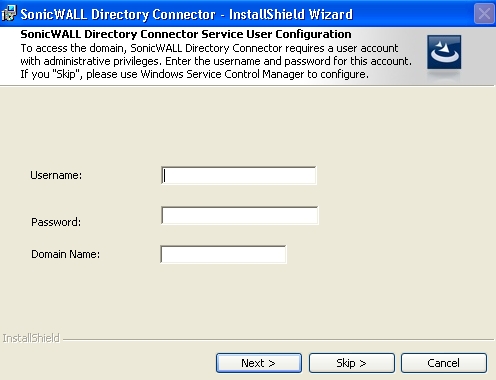

The SonicWALL SSO Agent installs. The status bar displays.
If you checked the
Launch SonicWALL Directory Connector
box, the SonicWALL Directory Connector will display.

Install the SonicWALL TSA on one or more terminal servers on your network within the
Windows domain. The SonicWALL TSA must have access to your SonicWALL security appliance, and the appliance must have access to the TSA. If you have a software firewall running on the terminal server, you may need to open up the UDP port number for incoming messages from the appliance.
SonicWALL TSA is available for download without charge from MySonicWALL. To install the
SonicWALL TSA, perform the following steps:
You can find these on
http://www.mysonicwall.com
.



The SonicWALL SSO Agent communicates with workstations using NetAPI or WMI, which both
provide information about users that are logged into a workstation, including domain users, local users, and Windows services. WMI is pre-installed on Windows Server 2003, Windows XP, Windows ME, and Windows 2000. For other Windows versions, visit www.microsoft.com to download WMI. Verify that WMI or NetAPI is installed prior to configuring the SonicWALL SSO Agent.
The .NET Framework 2.0 must installed prior to configuring the SonicWALL SSO Agent. The
.NET Framework can be downloaded from Microsoft at www.microsoft.com.
To configure the communication properties of the SonicWALL SSO Agent, perform the
following tasks:


If you clicked
Yes
, the message Successfully restored the old configuration
will display. Click OK
.

If you clicked
No
, or if you clicked Yes
but the default configuration is incorrect, the message SonicWALL SSO Agent service is not running. Please check the configuration and start
the service.
will display. Click OK
.

If the message
SonicWALL SSO Agent service is not running. Please check the
configuration and start the service
displays, the SSO Agent service will be disabled by default. To enable the service, expand the SonicWALL Directory Connector Configuration Tool in the left navigation panel by clicking the + icon, highlight the SonicWALL SSO Agent underneath it, and click the  button.
button.

|
Step 3
|
From the
Logging Level
pull-down menu, select the level of events to be logged in the Windows Event Log. The default logging level is 1. Select one of the following levels:
|
|
|
•
|
Logging Level 2
- All requests from the appliance are logged, using the debug level of severity.
|
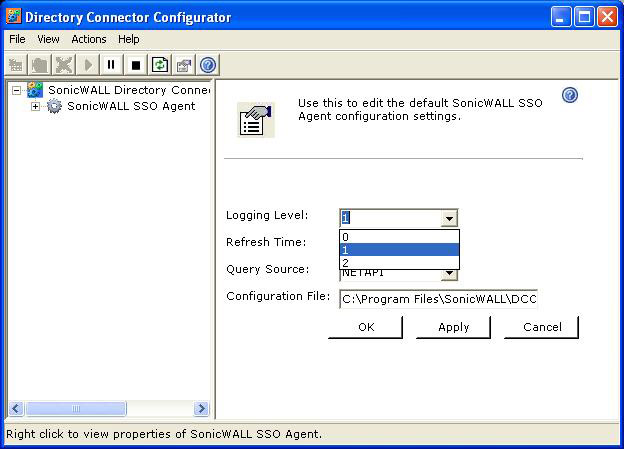
|
Step 4
|
In the
Refresh Time
field, enter the frequency, in seconds, that the SSO Agent will refresh user log in status. The default is 60 seconds.
|
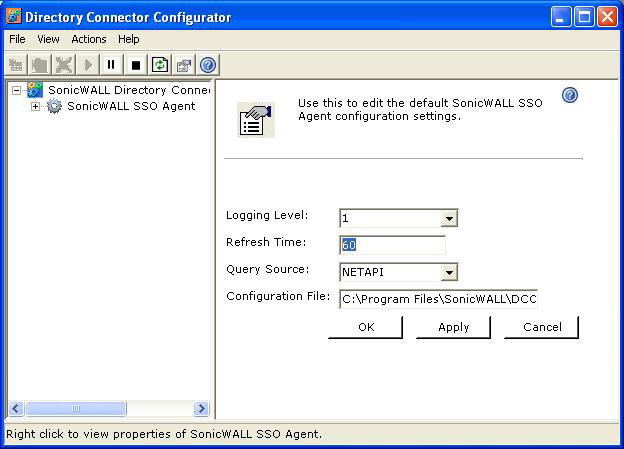
|
Step 5
|
From the
Query Source
pull-down menu, select the protocol that the SSO Agent will use to communicate with workstations, either NETAPI
or WMI
.
|
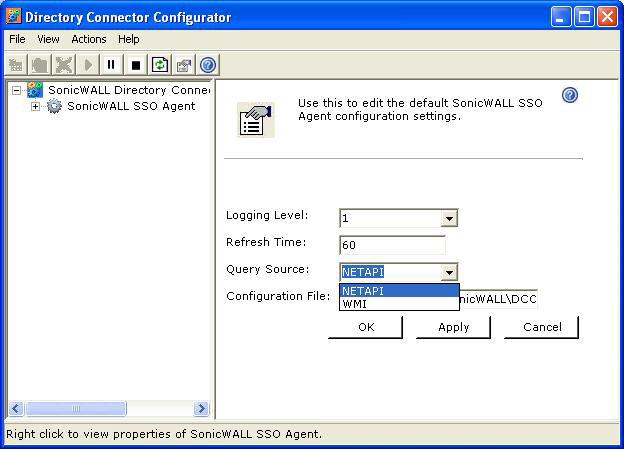
|
|
Note
|
NetAPI will provide faster, though possibly slightly less accurate, performance. WMI will
provide slower, though possibly more accurate, performance. With NetAPI, Windows reports the last login to the workstation whether or not the user is still logged in. This means that after a user logs out from his computer, the appliance will still show the user as logged in when NetAPI is used. If another user logs onto the same computer, then at that point the previous user is logged out from the SonicWALL.
|
WMI is pre-installed on Windows Server 2003, Windows XP, Windows Me, and Windows 2000.
Both NetAPI and WMI can be manually downloaded and installed. NetAPI and WMI provide information about users that are logged into a workstation, including domain users, local users, and Windows services.
User identification via the Domain Controller Security Log can be configured for WMI with a
non-administrator domain account. Although this option does not require use of the administrator domain account, it still requires read access to the security log, which can be accomplished by configuring a non-admin account. For more information, refer to the Configuring a Non-Admin Domain Account for SSO Agent to Read Security Logs
technical note in the Support > Product Documentation
page on SonicWALL.com.
|
Step 6
|
In the
Configuration File
field, enter the path for the configuration file. The default path is
C:\Program Files\SonicWALL\DCON\SSO\CIAConfig.xml
.
|

Use these instructions to manually add a SonicWALL security appliance if you did not add one
during installation, or to add additional SonicWALL security appliances.
To add a SonicWALL security appliance, perform the following steps:
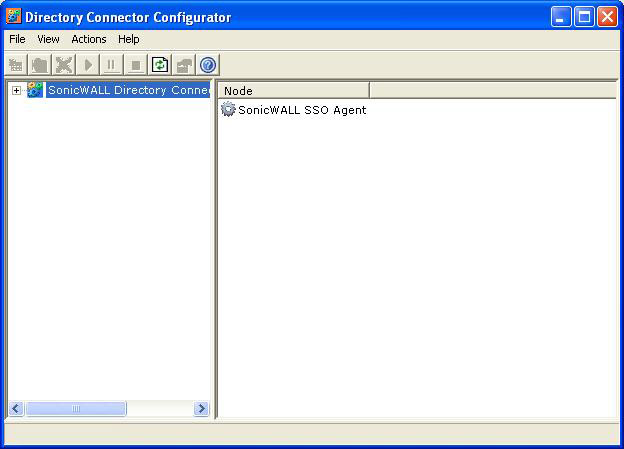
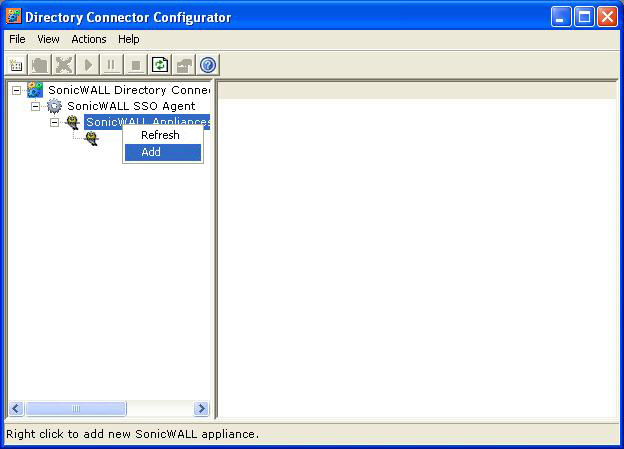
|
Step 3
|
Enter the appliance IP address for your SonicWALL security appliance in the
Appliance IP
field. Enter the port for the same appliance in the Appliance Port
field. The default port is 2258. Give your appliance a friendly name in the Friendly Name
field. Enter a shared key in the Shared Key
field or click Generate Key
to generate a shared key. When you are finished, click OK
.
|
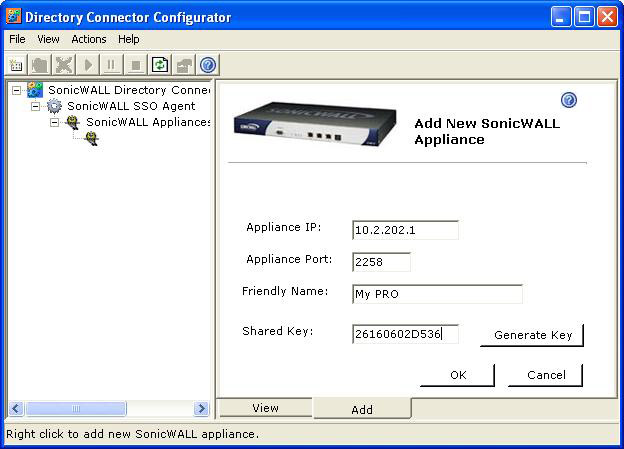
Your appliance will display in the left-hand navigation panel under the
SonicWALL Appliances
tree.

You can edit all settings on SonicWALL security appliances previously added in SonicWALL
SSO Agent, including IP address, port number, friendly name, and shared key. To edit a SonicWALL security appliance in SonicWALL SSO Agent, select the appliance from the left-hand navigation panel and click the edit icon  above the left-hand navigation panel. You can also click the Edit
tab at the bottom of the right-hand window.
above the left-hand navigation panel. You can also click the Edit
tab at the bottom of the right-hand window.
To delete a SonicWALL security appliance you previously added in SonicWALL SSO Agent,
select the appliance from the left-hand navigation panel and click the delete icon above the left-hand navigation panel.
above the left-hand navigation panel.
You can start, stop, and pause SonicWALL SSO Agent services to SonicWALL security
appliances. To pause services for an appliance, select the appliance from the left-hand navigation panel and click the pause button  . To stop services for an appliance, select the appliance from the left-hand navigation panel and click the stop button
. To stop services for an appliance, select the appliance from the left-hand navigation panel and click the stop button  . To resume services, click the start button
. To resume services, click the start button  .
.
After installing the SonicWALL TSA and restarting your Windows Server system, you can
double-click the SonicWALL TSA desktop icon created by the installer to launch it for configuration, to generate a trouble shooting report (TSR), or to see the status and version information.

See the following sections:
Perform the following steps to add a SonicWALL appliance to the SonicWALL TSA:

|
Step 3
|
Type the communication port into the
Appliance Port
field. The default port is 2259, but a custom port can be used instead. This port must be open on the Windows Server system.
|
|
Step 4
|
Type the encryption key into the
Shared Secret
field. Select the Show Secret
checkbox to view the characters and verify correctness. The same shared secret must be configured on the SonicWALL appliance.
|
|
Step 5
|
In the
Timeout
drop-down list, select the number of seconds that the agent will wait for a reply from the appliance before retrying the notification. The range is 5 to 10 seconds, and the default is 5 seconds.
|
|
Step 6
|
In the
Retries
drop-down list, select the number of times the agent will retry sending a notification to the appliance when it does not receive a reply. The range is 3 to 10 retries, and the default is 5.
|
|
Step 8
|
Click
Apply
. A dialog box indicates that the SonicWALL TSA service has restarted with the new settings.
|

You can create a trouble shooting report (TSR) containing all current log messages and
information about the agent, driver, and system settings to examine or to send to SonicWALL Technical Support for assistance.
Perform the following steps to create a TSR for the SonicWALL TSA:
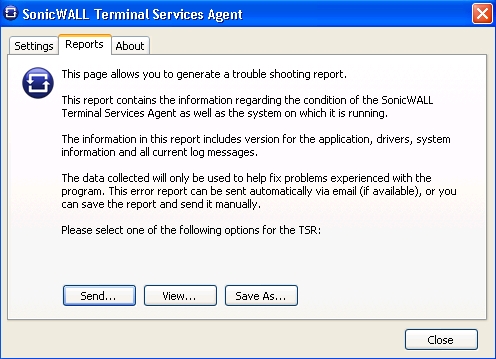
To display the current status of the SonicWALL TSA service on your Windows Server system,
or to view the version number of the SonicWALL TSA, perform the following steps:

To use single sign-on, your SonicWALL security appliance must be configured to use either
SonicWALL SSO Agent
or Browser NTLM authentication only
as the SSO method. SonicWALL SSO Agent
is also the correct method to select when configuring the appliance to use the SonicWALL Terminal Services Agent.
The following procedure describes how to configure your SonicWALL security appliance to use
SonicWALL SSO Agent
. Perform the following steps:
|
Step 2
|
In the
Single-sign-on
method
drop-down menu, select SonicWALL SSO Agent
. Use this choice to add and configure a TSA as well as an SSO Agent for the SSO method.
|
|
Step 3
|
Click
Configure
.The Authentication Agent Settings page displays, showing any Authentication Agents already configured. The green LED next to the Agent’s IP address indicates that the agent is currently up and running. A red LED would indicate that the agent is down. A grey LED shows that the agent is disabled. The LEDs are dynamically updated using AJAX.
|

|
Step 5
|
In the
Host Name or IP Address
field, enter the name or IP address of the workstation on which SonicWALL SSO Agent is installed.
As you type in values for the fields, the row at the top is updated in red to highlight the new information.
|
|
Step 6
|
In the
Port
field, enter the port number of the workstation on which SonicWALL SSO Agent is installed. The default port is 2258. Note that agents at different IP addresses can have the same port number.
|
|
Step 7
|
In the
Shared Key
field, enter the shared key that you created or generated in the SonicWALL SSO Agent. The shared key must match exactly. Re-enter the shared key in the Confirm
Shared Key
field.
|
|
Step 8
|
In the
Timeout (seconds)
field, enter a number of seconds before the authentication attempt times out. This field is automatically populated with the default of 10 seconds.
|
|
Step 9
|
In the
Retries
field, enter the number of authentication attempts.
|
|
Step 10
|
Click the
Advanced
tab in the lower half of the page.
|
|
Step 11
|
In the
Maximum requests to send at a time
field, enter the maximum number of requests to send from the appliance to the agent at one time. The default is 32.
|
The agent processes multiple requests concurrently, spawning a separate thread in the agent
PC to handle each. Sending too many requests at a time can overload the PC. On the other hand, if the number of requests to be sent from the appliance exceeds the maximum, then some requests will wait on an internal “ring buffer” queue. Too many requests waiting could lead to slow response times in Single Sign On authentication. For more information, see “
Tuning Single Sign-On Advanced Settings
”
.
|
Step 12
|
Click the
Users
tab. The User Settings page displays.
|
|
Step 13
|
Check the box next to
Allow only users listed locally
to allow only users listed locally on the appliance to be authenticated.
|
|
Step 14
|
Check the box next to
Simple user names in local database
to use simple user names. When selected, the domain component of a user name will be ignored. User names returned from the authentication agent typically include a domain component, for example, domain1/user1. If this box is not checked, user names in the local database must match exactly the full names returned from the agent, including the domain component.
|
|
Step 15
|
Check the box next to
Allow limited access for non-domain users
to allow limited access to users who are logged in to a computer but not into a domain. These users will not be given membership in the Trusted Users user group, even when set locally, and so will not get any access set for Trusted Users. They are identified in logs as computer-name/user-name
. When using the local user database to authenticate users, and the Simple user names in local
database
option is disabled, user names must be configured in the local database using the full computer-name/user-name
identification.
|
|
Step 16
|
If your network includes non-Windows devices or Windows computers with personal firewalls
running, check the box next to Probe user for
and select the radio button for either NetAPI
or WMI
depending on which is configured for the SSO Agent. This causes the SonicWALL network security appliance to probe for a response on the NetAPI/WMI port before requesting that the SSO Agent identify a user. If no response occurs, these devices will fail SSO immediately. Such devices do not respond to, or may block, the Windows networking messages used by the SSO Agent to identify a user.
|
|
Step 17
|
In the
Probe timeout
field, enter the number of seconds that the firewall should wait for a response from the agent on the NetAPI/WMI port. The probe is considered failed after this period. The default is 5 seconds.
|
|
Step 18
|
To enable probing on the NetAPI/WMI port without aborting the SSO attempt if the probes fail,
select the Probe test mode
checkbox. Probe test mode is used to ensure that the probes do not cause failures where SSO could have worked if they were not used. If probe failures are reported when SSO is working, then either the probe timeout is too short or something in the network may be blocking them. For example, if you have an Access Control List set on a router in your network to allow NetAPI from the agent’s IP address only, that ACL will block the probes to the NetAPI port from the appliance.
|
Probe test mode is useful for initial SSO deployment and troubleshooting. When Probe test
mode is enabled, you can analyze the behavior by:
If the statistics show 100% probe failures, then something is wrong in the network. If they show
intermittent failures, you can try varying the Probe timeout
setting to see if it helps.
|
Step 21
|
In the
Polling rate (minutes)
field, enter a polling interval, in minutes. The security appliance will poll the workstation running SSO Agent once every interval to verify that users are still logged on. The default is 1.
|
|
Step 22
|
In the
Hold time after (minutes)
field, enter a time, in minutes, that the security appliance will wait before trying again to identify traffic after an initial failure to do so. This feature rate-limits requests to the agent. The default is 1.
|
|
Step 23
|
To populate the
User names used by Windows services
list, click the Add
button. In the Service User name dialog box, type the service login name (the simple name only, without the domain or PC name) into the Enter the name of a user account used by a Windows service
field and then click OK
.
|

The purpose of this list is to distinguish the login names used by Windows services from real
user logins. When the SSO agent queries Windows to find the user logged into a computer, Windows actually returns a list of user accounts that are/have been logged in to the computer and does not distinguish user logins from service logins, hence giving the SSO agent no way to determine that a login name belongs to a service. This may result in the SSO agent incorrectly reporting a service name instead of the actual user name.
You can enter up to 64 login names here that may be used by services on end-user computers.
The SSO agent will ignore any logins using these names.
If, when using Single Sign On, you see unexpected user names shown on the Users > Status
page, or logs of user login or user login failure with unexpected user names, those may be due to Windows service logins and those user names should be configured here so that the SSO agent will know to ignore them.
In cases where there are multiple SonicWALL appliances communicating with an SSO agent,
the list of service account names should be configured on only one of them. The effect of configuring multiple lists on different appliances is undefined.
To edit a service account name, select the name, click
Edit
, make the desired changes in the Service User name dialog box, and then click OK
.
To remove service account names, select one or more names and then click
Remove
.
|
Step 24
|
Click on the
Enforcement
tab if you want to either trigger SSO on traffic from a particular zone, or bypass SSO for traffic from non-user devices such as internal proxy web servers or IP phones.
|
|
Step 25
|
Under
Per-Zone SSO Enforcement
, select the checkboxes for any zones on which you want to trigger SSO to identify users when traffic is sent. If SSO is already required on a zone by Application Control or other policies, those checkboxes are pre-selected and cannot be cleared. If Guest Services is enabled on a zone, SSO cannot be enforced and you cannot select the checkbox.
|
These per-zone SSO enforcement settings are useful for identifying and tracking users in event
logging and App Flow Monitor visualizations, even when SSO is not otherwise triggered by content filtering, IPS, or Application Control policies, or by firewall access rules requiring user authentication.
On zones where security services policies or firewall access rules are set to require user
authentication, SSO will always be initiated for the affected traffic and it is not necessary to also enable SSO enforcement here.
The first setting is used where traffic that would be subject to security services screening can
emanate from a device other than a user's workstation (such as an internal proxy Web server or IP phone). It prevents the SonicWALL from attempting to identify such a device as a network user in order to select the content filtering policy to apply. The default content filtering policy will be used for all traffic from the selected IP addresses.
The second setting is appropriate for user traffic that does not need to be authenticated, and
triggering SSO might cause an unacceptable delay for the service.
SSO bypass settings do not apply when SSO is triggered by firewall access rules requiring user
authentication. To configure this type of SSO bypass, add access rules that do not require user authentication for the affected traffic. See “Adding Access Rules”
for more information on configuring access rules.
|
Step 27
|
Click the
Terminal Services
tab. The Terminal Services Agent Settings page displays.
|
|
Step 28
|
Within this page, on the
Terminal Services Agents
tab, click the Add
button. The page is updated to display a new row in the table at the top, and new input fields in the lower half of the page.
|

For existing agents, a green LED-style icon next to an agent indicates that the agent is up and
running. A red LED icon indicates that the agent is down. A yellow LED icon means that the TSA is idle and the appliance has not heard anything from it for 5 minutes or more. Because TSA sends notifications to the appliance rather than the appliance sending requests to the agent, a lack of notifications could mean that there is a problem, but more likely means simply that no user on the terminal server is currently doing anything.
|
Step 29
|
In the
Host Name or IP Address(es)
field, enter the name or IP address of the terminal server on which SonicWALL TSA is installed. If the terminal server is multi-homed (has multiple IP addresses) and you are identifying the host by IP address rather than DNS name, enter all the IP addresses as a comma-separated list.
|
As you type in values for the fields, the row at the top is updated in red to highlight the new
information.
|
Step 30
|
In the
Port
field, enter the port number of the workstation on which SonicWALL TSA is installed. The default port is 2259. Note that agents at different IP addresses can have the same port number.
|
|
Step 31
|
In the
Shared Key
field, enter the shared key that you created or generated in the SonicWALL TSA. The shared key must match exactly. Re-enter the shared key in the Confirm Shared Key
field.
|
|
Step 33
|
The
Allow traffic from services on the terminal server to bypass user authentication in
access rules
checkbox is selected by default. This allows traffic such as Windows updates or anti-virus updates, which is not associated with any user login session, to pass without authentication. If you clear this checkbox, traffic from services can be blocked if firewall access rules require user authentication. In this case, you can add rules to allow access for “All” to the services traffic destinations, or configure the destinations as HTTP URLs that can bypass user authentication in access rules.
|
|
Step 34
|
Click the
NTLM
tab. The NTLM Browser Authentication page displays. NTLM authentication is supported by Mozilla-based browsers and can be used as a supplement to identifying users via an SSO agent or, with some limitations, on its own without the agent. The SonicWALL appliance interacts directly with the browser to authenticate the user. Users logged in with domain credentials are authenticated transparently; in other cases the user may need to enter credentials to log in to the appliance, but should only need to do so once as the credentials are saved.
|
Consult the tooltips on this tab for additional details, and see
“How Does Browser NTLM Authentication Work?”
for more information.

|
|
•
|
Never
– Never use NTML authentication.
|
|
Step 36
|
For
Authentication domain
, do one of the following:
|
|
|
•
|
Select the
Use the domain from the LDAP configuration
checkbox to use the same domain that is used in the LDAP configuration.
|
Fully transparent authentication can only occur if the browser sees the appliance domain as the
local domain.
|
Step 37
|
For
Redirect the browser to this appliance via
, select one of the folllowing options to determine how a user’s browser is initially redirected to the SonicWALL appliance’s own Web server:
|
|
|
•
|
The interface IP address
– Select this to redirect the browser to the IP address of the appliance Web server interface.
|
|
|
•
|
Its domain name from a reverse DNS lookup of the interface IP address
– Enables the Show Reverse DNS Cache
button at the bottom of the window; when clicked, a popup displays the appliance Web server’s Interface, IP Address, DNS Name, and TTL in seconds. Click the button to verify the domain name (DNS name) being used for redirecting the user’s browser.
|
|
|
•
|
Its domain name
– Type in the Web server domain name to which the user’s browser should be redirected.
|
|
|
•
|
Poll via the SSO agent
– If you are using an SSO Agent in your network, select this to use it to poll users; for users authenticated via NTLM, the user name that the agent learns must match the name used for the NTLM authentication, or the login session will be terminated. You may want to select a different polling method for Linux or Mac users, as those systems do not support the Windows networking requests used by the SSO agent.
|
|
|
•
|
Re-authenticate via NTLM
– This method is transparent to the user if the browser is configured to store the domain credentials, or the user instructed the browser to save the credentials.
|
|
|
•
|
Don’t re-authenticate
– If you select this option, logout will not be detected other than via the inactivity timeout.
|
|
Step 41
|
Click the
Test
tab. The Test Authentication Agent Settings page displays. You can test the connectivity between the appliance and an SSO agent or TSA. You can also test whether the SSO agent is properly configured to identify a user logged into a workstation.
|
|
Step 43
|
Select the
Check agent connectivity
radio button and then click the Test
button. This will test communication with the authentication agent. If the SonicWALL security appliance can connect to the SSO agent, you will see the message Agent is ready
. If testing a TSA, the Test Status
field displays the message, and the version and server IP address are displayed in the Information returned from the agent
field.
|
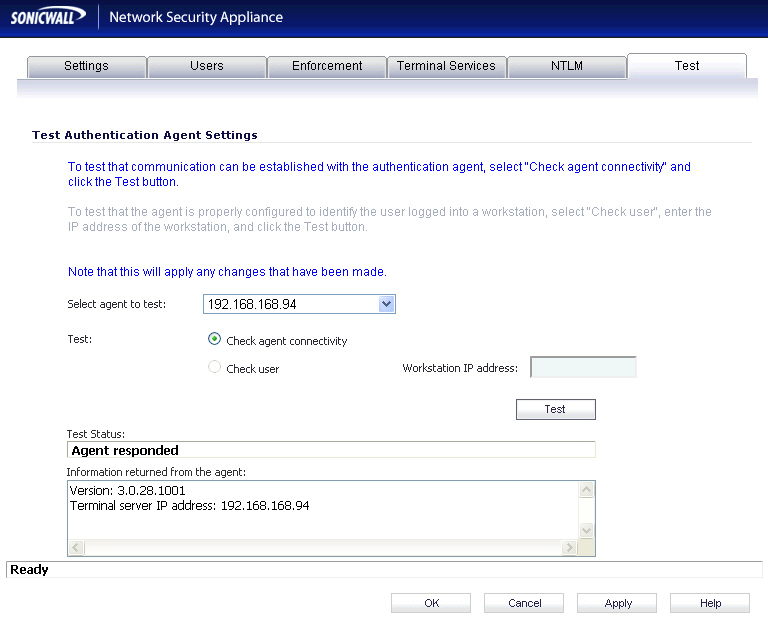
|
Step 44
|
For SSO agents only, select the
Check user
radio button, enter the IP address of a workstation in the Workstation IP address
field, then click Test
. This will test if the SSO agent is properly configured to identify the user logged into a workstation.
|
To use single sign-on, your SonicWALL security appliance must be configured to use either
SonicWALL SSO Agent
or Browser NTLM authentication only
as the SSO method.
The following procedure describes how to configure your SonicWALL security appliance to use
Browser NTLM authentication only
. Perform the following steps:
In the
Single-sign-on
method
drop-down menu, select Browser NTLM authentication only
.

|
Step 2
|
Click
Configure
. The SonicWALL SSO Agent Configuration window displays.
|
|
Step 4
|
Click the
Users
tab. The User Settings page displays.
|
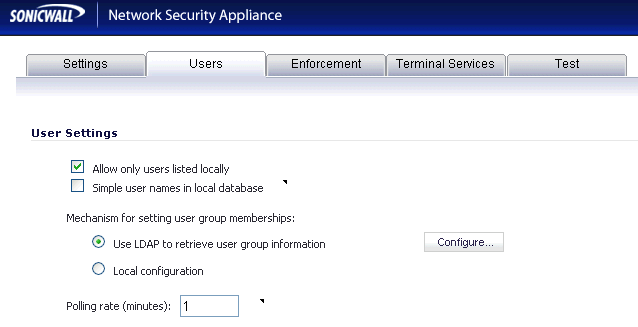
|
Step 5
|
Check the box next to
Allow only users listed locally
to allow only users listed locally on the appliance to be authenticated.
|
|
Step 6
|
Check the box next to
Simple user names in local database
to use simple user names. When selected, the domain component of a user name will be ignored. User names returned from the authentication agent typically include a domain component, for example, domain1/user1. If this box is not checked, user names in the local database must match exactly the full names returned from the agent, including the domain component.
|
|
Step 9
|
In the
Polling rate (minutes)
field, enter a polling interval, in minutes. The security appliance will poll the workstation running SSO Agent once every interval to verify that users are still logged on. The default is 1.
|
When LDAP is selected in the
Authentication method for login
field, RADIUS configuration is still required when using NTLM authentication. NTLM authentication requires MSCHAP, which is provided by RADIUS but not by LDAP.
The
Configure
button next to RADIUS may also be required for CHAP/NTLM
is enabled when LDAP authentication is selected on the Users > Settings page.
If LDAP is configured, then it will be used for user group membership lookups after a user’s
credentials provided by NTLM have been authenticated via RADIUS. Thus, when using NTLM it is not necessary to configure RADIUS to return user group membership information (which can be very complex to do with some RADIUS servers, such as IAS).
To configure RADIUS settings, click the
Configure
button and follow the instructions in the “Configuring RADIUS Authentication” section
.
In Microsoft Windows 7 and Vista, Internet Explorer uses the
NTLMv2
variant of NTLM by default. The NTLMv2 variant cannot be authenticated via RADIUS in the same way as NTLM. To use browser NTLM authentication as the SSO method with these versions of Windows, the Windows machines must be configured to use NTLMv2 Session Security
instead of NTLMv2. NTLMv2 Session Security is a variant that is designed to be compatible with RADIUS/MSCHAPv2. This configuration is performed using Windows Group Policy.
To configure a Windows 7 or Vista machine to use NTLMv2 Session Security, perform the
following steps:
|
Step 2
|
Select
Local Security Policy
to open the Local Security Policy window.
|
|
Step 3
|
Expand
Local Policies
and click on Security Options
.
|
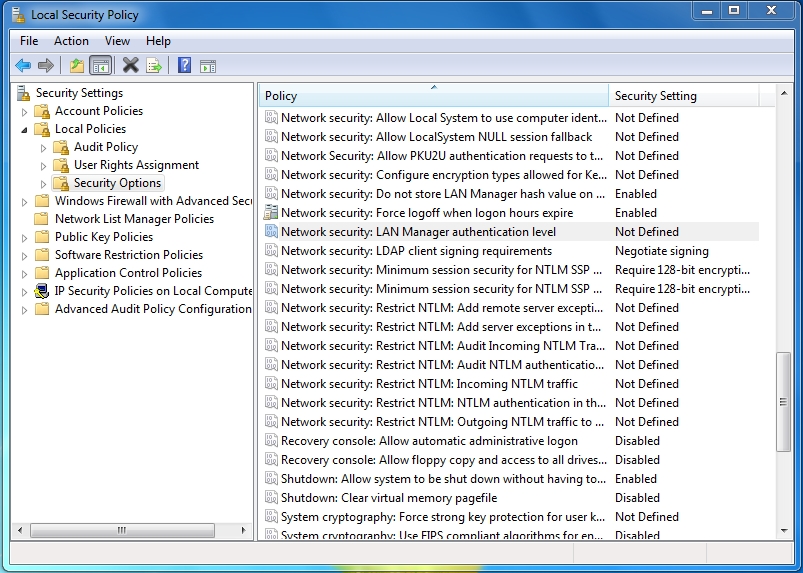
|
Step 4
|
Edit the
Network Security: LAN Manager authentication level
setting and select one of the following:
|
|
|
•
|
Set the
Network Security: Restrict NTLM: NTLM authentication in this domain
to Deny
all
.
|
|
|
•
|
Set the
Network Security: Restrict NTLM: Outgoing NTLM traffic to remote servers
to Deny all
.
|
Then, do one or both of the following:
If you selected
Use LDAP to retrieve user group information
on the Users
tab in step 19
of “
Configuring Your SonicWALL Security Appliance for SonicWALL SSO Agent
”
, you must configure your LDAP settings. To configure LDAP settings, perform the following steps:
|
Step 1
|
On the
Users
tab in the SSO Configure window, click the Configure
button next to the Use
LDAP to retrieve user group information
option.
|
|
Step 2
|
The
Settings
tab displays. In the Name or IP address
field, enter the name or IP address of your LDAP server.
|
|
Step 3
|
In the
Port Number
field, enter the port number of your LDAP server. The default LDAP ports are:
|
|
Step 4
|
In the
Server timeout (seconds)
field, enter a number of seconds the SonicWALL security appliance will wait for a response from the LDAP server before the attempt times out. Allowable values are 1 to 99999. The default is 10 seconds.
|
|
Step 5
|
In the
Overall operation timeout (minutes)
field, enter a number of minutes the SonicWALL security appliance will spend on any automatic operation before timing out. Allowable values are 1 to 99999. The default is 5 minutes.
|
|
Step 6
|
Select the
Anonymous login
radio button to log in anonymously. Some LDAP servers allow for the tree to be accessed anonymously. If your server supports this (MS AD generally does not), you may select this option.
|
Select
Give login name / location in tree
to access the tree with the login name.
Select
Give bind distinguished name
to access the tree with the distinguished name.
|
|
Note
|
Use the user’s name in the
Login user name
field, not a username or login ID. For example, John Doe would log in as John Doe, not jdoe.
|
|
Step 8
|
Select the LDAP version from the
Protocol version
drop-down menu, either LDAP version 2
or LDAP version 3
. Most implementations of LDAP, including AD, employ LDAP version 3.
|
|
Step 9
|
Select the
Use TLS (SSL)
checkbox to use Transport Layer Security (SSL) to log in to the LDAP server. It is strongly recommended to use TLS to protect the username and password information that will be sent across the network. Most implementations of LDAP server, including AD, support TLS.
|
|
Step 10
|
Select the
Send LDAP ‘Start TLS’ request
checkbox to allow the LDAP server to operate in TLS and non-TLS mode on the same TCP port. Some LDAP server implementations support the Start TLS directive rather than using native LDAP over TLS. This allows the LDAP server to listen on one port (normally 389) for LDAP connections, and to switch to TLS as directed by the client. AD does not use this option, and it should only be selected if required by your LDAP server.
|
|
|
Note
|
Only check the
Send LDAP ‘Start TLS’ request
box if your LDAP server uses the same port number for TLS and non-TLS.
|
|
Step 11
|
Select the
Require valid certificate from server
checkbox to require a valid certificate from the server. Validates the certificate presented by the server during the TLS exchange, matching the name specified above to the name on the certificate. Deselecting this default option will present an alert, but exchanges between the SonicWALL security appliance and the LDAP server will still use TLS – only without issuance validation.
|
|
Step 12
|
Select a local certificate from the
Local certificate for TLS
drop-down menu. This is optional, to be used only if the LDAP server requires a client certificate for connections. This feature is useful for LDAP server implementations that return passwords to ensure the identity of the LDAP client (AD does not return passwords). This setting is not required for AD.
|
|
Step 15
|
From the
LDAP Schema
drop-down menu, select one of the following LDAP schemas. Selecting any of the predefined schemas will automatically populate the fields used by that schema with their correct values. Selecting ‘user-defined’ will allow you to specify your own values – use this only if you have a specific or proprietary LDAP schema configuration.
|
|
Step 16
|
The
Object class
field defines which attribute represents the individual user account to which the next two fields apply. This will not be modifiable unless you select User defined.
|
|
Step 17
|
The
Login name attribute
field defines which attribute is used for login authentication. This will not be modifiable unless you select User defined
.
|
|
Step 18
|
If the
Qualified login name attribute
field is not empty, it specifies an attribute of a user object that sets an alternative login name for the user in name@domain
format. This may be needed with multiple domains in particular, where the simple login name may not be unique across domains. For Microsoft Active Directory, this is typically set to userPrincipalName
for login using name@domain
. This can also be set to mail
for Active Directory and RFC2798 inetOrgPerson.
|
|
Step 19
|
The
User group membership attribute
field contains the information in the user object of which groups it belongs to. This is memberOf
in Microsoft Active Directory. The other predefined schemas store group membership information in the group object rather than the user object, and therefore do not use this field.
|
|
Step 20
|
In the
Additional user group ID attribute
field, enter the attribute that contains the user’s primary group ID. This field is used to get primary user group information for user accounts, and works together with the Additional user group match attibute
option. To enable database searches for the user group information, select the Use
checkbox.
|
Windows has the concept of each user having a primary user group, which is normally
Domain
Users
for domain users and Admin Users
for administrators. However, an LDAP search for a user’s group memberships does not include that primary group in the list returned from Active Directory. Therefore, to allow setting rules and policies for the Domain Users
or Admin Users
groups, the appliance also needs to retrieve a user’s primary user group with a separate LDAP search.
An attribute must be used for the search, because in Active Directory the user’s primary group
is not set by name as other user group memberships are. Instead, it is set in the user object by a primaryGroupID
attribute that gives an ID number, that ID number being given in the user group object by a primaryGroupToken
attribute.
To allow these user groups to be used on the appliance for applying group policies, after
reading the user object with its user group memberships from LDAP, the appliance needs to perform an additional search for a user group with a primaryGroupToken
attribute matching the user’s primaryGroupID
attribute.
Use of these attributes is off by default, as there is additional time overhead in user group
searches. The Use
checkbox must be enabled to search for a user’s primary user group.
Although this is primarily for attributes of Active Directory, it can operate with any schema to
allow a search for one additional user group by setting appropriate attribute values in the Additional user group ID attribute
and Additional user group match attribute
fields. These fields default to primaryGroupID
and primaryGroupToken
when Active Directory is selected.
|
Step 21
|
The
Framed IP address attribute
field can be used to retrieve a static IP address that is assigned to a user in the directory. Currently it is only used for a user connecting using L2TP with the SonicWALL security appliance L2TP server. In future releases, this may also be supported for the SonicWALL Global VPN Client (GVC). In Active Director, the static IP address is configured on the Dial-in tab of a user’s properties.
|
|
Step 22
|
The
Object class
field defines the type of entries that an LDAP directory may contain. A sample object class, as used by AD, would be ‘user’ or ‘group’.
|
|
Step 23
|
The
Member attribute
field defines which attribute is used for login authentication.
|
|
Step 24
|
The
Additional user group match attribute
field defines the attribute that contains the user group ID for the user. The Additional user group match attribute
field works together with the Additional user group ID attribute
field. For more information about these fields, see Step 20
above.
|
|
Step 26
|
In the
Primary Domain
field, specify the user domain used by your LDAP implementation. For AD, this will be the Active Directory domain name, such as yourADdomain.com
. Changes to this field will, optionally, automatically update the tree information in the rest of the page. This is set to mydomain.com
by default for all schemas except Novell eDirectory, for which it is set to o=mydomain
.
|
|
Step 27
|
In the
User tree for login to server
field, specify the tree in which the user specified in the ‘Settings’ tab resides. For example, in AD the ‘administrator’ account’s default tree is the same as the user tree.
|
|
Step 28
|
In the
Trees containing users
field, specify the trees where users commonly reside in the LDAP directory. One default value is provided that can be edited, a maximum of 64 DN values may be provided, and the SonicWALL security appliance searches the directory until a match is found, or the list is exhausted. If you have created other user containers within your LDAP or AD directory, you should specify them here.
|
|
Step 29
|
In the
Trees containing user groups
specify the trees where user groups commonly reside in the LDAP directory. A maximum of 32 DN values may be provided. These are only applicable when there is no user group membership attribute in the schema's user object, and are not used with AD.
|
The above-mentioned trees are normally given in URL format but can alternatively be specified
as distinguished names (for example, “myDom.com/Sales/Users” could alternatively be given as the DN “ou=Users,ou=Sales,dc=myDom,dc=com
”). The latter form will be necessary if the DN does not conform to the normal formatting rules as per that example. In Active Directory the URL corresponding to the distinguished name for a tree is displayed on the Object tab in the properties of the container at the top of the tree.
Ordering is not critical, but since they are searched in the given order it is most efficient to place
the most commonly used trees first in each list. If referrals between multiple LDAP servers are to be used, then the trees are best ordered with those on the primary server first, and the rest in the same order that they will be referred.
|
Step 30
|
The
Auto-configure
button causes the SonicWALL security appliance to auto-configure the ‘Trees containing users’ and ‘Trees containing user groups’ fields by scanning through the directory/directories looking for all trees that contain user objects. The ‘User tree for login to server’ must first be set.
|
Select whether to append new located trees to the current configuration, or to start from scratch
removing all currently configured trees first, and then click OK
. Note that it will quite likely locate trees that are not needed for user login and manually removing such entries is recommended.
If using multiple LDAP/AD servers with referrals, this process can be repeated for each,
replacing the ‘Domain to search’ accordingly and selecting ‘Append to existing trees’ on each subsequent run.
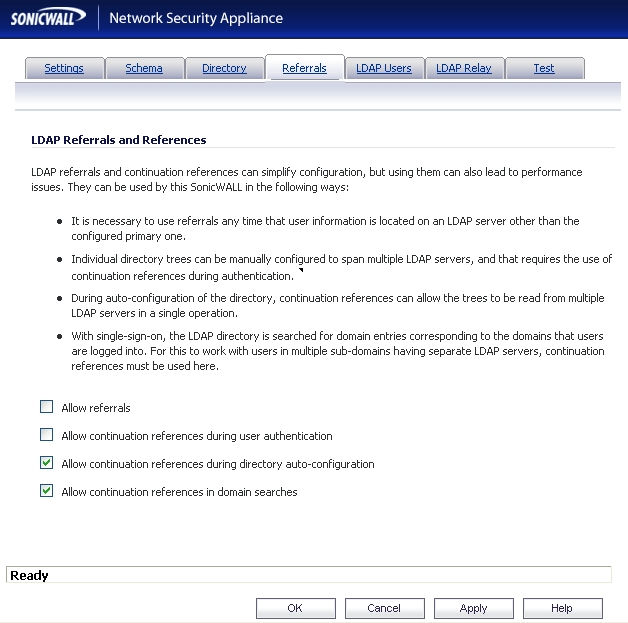
|
|
•
|
Allow referrals
– Select when user information is located on an LDAP server other than the primary one.
|
|
Step 34
|
Check the
Allow only users listed locally
box to require that LDAP users also be present in the SonicWALL security appliance local user database for logins to be allowed.
|
|
Step 35
|
Check the
User group membership can be set locally by duplicating LDAP user names
box to allow for group membership (and privileges) to be determined by the intersection of local user and LDAP user configurations.
|
|
Step 36
|
From the
Default LDAP User Group
drop-down menu, select a default group on the SonicWALL security appliance to which LDAP users will belong in addition to group memberships configured on the LDAP server.
|
|
|
Tip
|
Group memberships (and privileges) can also be assigned simply with LDAP. By creating
user groups on the LDAP/AD server with the same name as SonicWALL security appliance built-in groups (such as Guest Services
, Content Filtering Bypass
, Limited
Administrators
) and assigning users to these groups in the directory, or creating user groups on the SonicWALL security appliance with the same name as existing LDAP/AD user groups, SonicWALL group memberships will be granted upon successful LDAP authentication.
|
The SonicWALL security appliance can retrieve group memberships more efficiently in the case
of Active Directory by taking advantage of its unique trait of returning a ‘memberOf’ attribute for a user.
|
Step 37
|
Click the
Import user groups
button to import user groups from the LDAP server. The names of user groups on the LDAP server need to be duplicated on the SonicWALL if they are to be used in policy rules, CFS policies, etc.
|
|
Step 39
|
Select the
Enable RADIUS to LDAP Relay
checkbox to enable RADIUS to LDAP relay. The RADIUS to LDAP Relay feature is designed for use in a topology where there is a central site with an LDAP/AD server and a central SonicWALL security appliance with remote satellite sites connected into it using SonicWALL security appliances that may not support LDAP. In that case the central SonicWALL security appliance can operate as a RADIUS server for the remote SonicWALL security appliances, acting as a gateway between RADIUS and LDAP, and relaying authentication requests from them to the LDAP server.
|
Additionally, for remote SonicWALL security appliances running non-enhanced firmware, with
this feature the central SonicWALL security appliance can return legacy user privilege information to them based on user group memberships learned using LDAP. This avoids what can be very complex configuration of an external RADIUS server such as IAS for those SonicWALL security appliances.
|
Step 40
|
Under
Allow RADIUS clients to connect via
, select the relevant checkboxes and policy rules will be added to allow incoming RADIUS requests accordingly. The options are:
|
|
Step 41
|
In the
RADIUS shared secret
field, enter a shared secret common to all remote SonicWALL security appliances.
|
|
Step 42
|
In the
User groups for legacy users
fields, define the user groups that correspond to the legacy ‘VPN users,’ ‘VPN client users,’ ‘L2TP users’ and ‘users with Internet access’ privileges. When a user in one of the given user groups is authenticated, the remote SonicWALL security appliances will be informed that the user is to be given the relevant privilege.
|
The ‘Test’ page allows for the configured LDAP settings to be tested by attempting
authentication with specified user and password credentials. Any user group memberships and/or framed IP address configured on the LDAP/AD server for the user will be displayed.
|
Step 44
|
In the
Username
and Password
fields, enter a valid LDAP login name for the LDAP server you configured.
|
|
Step 45
|
Select
Password authentication
or CHAP
(Challenge Handshake Authentication Protocol).
|
|
Step 46
|
Click
Test
. Status and information returned from the LDAP server are displayed in the Test
Status
, Message from LDAP
, and Returned User Attributes
fields.
|
This section provides detailed information to help you tune the advanced SSO settings on your
SonicWALL appliance. See the following sections:
When a user first tries to send traffic through a SonicWALL that is using SSO, the appliance
sends a “who is this” request to SonicWALL SSO Agent. The agent queries the user’s PC via Windows networking, and returns the user name to the SonicWALL appliance. If the user name matches any criteria set in the policies, then the user is considered as “logged on” by the SonicWALL. When users are logged into the SonicWALL using SSO, the SSO feature also provides detection of logouts. To detect logouts, the appliance repeatedly polls the agent to check if each user is still logged in. This polling, along with the initial identification requests, could potentially result in a large loading on the SonicWALL SSO Agent application and the PC on which it is running, especially when very large numbers of users are connecting.
The SonicWALL SSO feature utilizes a rate-limiting mechanism to prevent the appliance from
swamping the agent with these user requests. Both automatic calculations and a configurable setting on the appliance govern how this rate-limiting operates. The SonicWALL SSO feature automatically calculates the maximum number of user requests contained in each message to the agent that can be processed in the poll period, based on recent polling response times. Also, the timeout on a multi-user request is automatically set to be long enough to reduce the likelihood of an occasional long timeout during polling. The configurable setting controls the number of requests to send to the agent at a time, and can be tuned to optimize SSO performance and prevent potential problems. This section provides a guide to choosing suitable settings.
The potential for problems resulting from overloading the agent can be reduced by running the
agent on a dedicated high-performance PC, and possibly also by using multiple agents on separate PCs, in which case the load will be shared between them. The latter option also provides redundancy in case one of the agent PCs fails. The agent should run on a Windows Server PC (some older workstations could be used but changes in later Windows 2000/XP/Vista workstation releases and in service packs for the older versions added a TCP connection rate limiting feature that interferes with operation of the SSO agent).
The
Maximum requests to send at a time
setting is available on the Advanced
tab of the SSO agent configuration.
This setting controls the maximum number of requests that can be sent from the appliance to
the agent at the same time. The agent processes multiple requests concurrently, spawning a separate thread in the PC to handle each. Sending too many requests at a time can overload the PC on which the agent is running. If the number of requests to send exceeds the maximum, then some are placed on an internal “ring buffer” queue (see “
Using the Single Sign-On Statistics in the TSR
”
and “
Viewing SSO Mouseover Statistics and Tooltips
”
). Requests waiting on the ring buffer for too long could lead to slow response times in SSO authentication.
This setting works in conjunction with the automatically calculated number of user requests per
message to the agent when polling to check the status of logged in users. The number of user requests per message is calculated based on recent polling response times. SonicOS adjusts this number as high as possible to minimize the number of messages that need to be sent, which reduces the load on the agent and helps reduce network traffic between the appliance and the agent. However, the number is kept low enough to allow the agent to process all of the user requests in the message within the poll period. This avoids potential problems such as timeouts and failures to quickly detect logged out users.
The SSO Configuration page provides mouseover statistics about each agent, and mouseover
tooltips for many fields. On the Settings tab, a green LED-style icon next to an agent indicates that the agent is up and running. A red LED icon indicates that the agent is down.
To view the statistics for a particular agent, hover your mouse pointer over the statistics icon
 to the right of the SSO agent. This also works for individual TSAs on the Terminal Services tab.
to the right of the SSO agent. This also works for individual TSAs on the Terminal Services tab.

To view the statistics for all SSO activity on the appliance, hover your mouse pointer over the
statistics icon at the bottom of the table, in the same row as the Add
button.
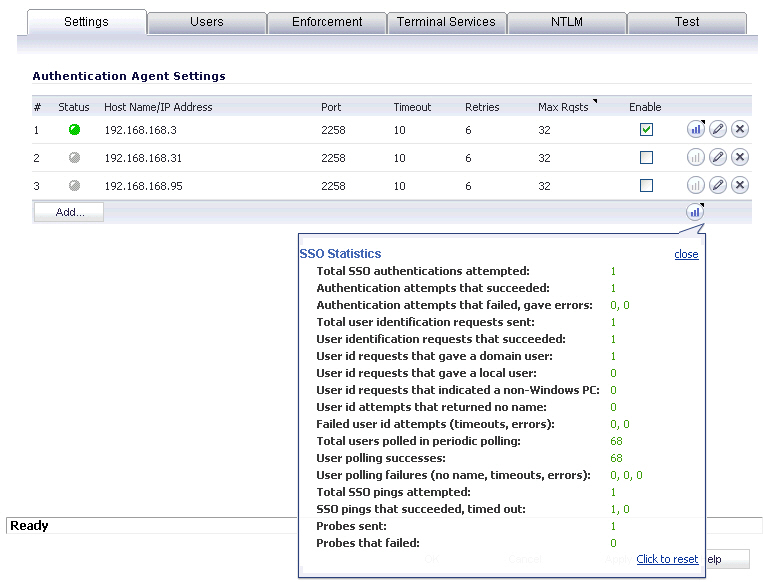
To close the statistics display, click
close
.
To clear all the displayed values, click
Click to reset
.
To view the tooltips available for many fields in the SSO configuration screens, hover your
mouse pointer over the triangular icon to the right of the field. The tooltip will display until you move your mouse pointer away.

A rich set of SSO performance and error statistics is included in the trouble shooting report
(TSR). These can be used to gauge how well SSO is performing in your installation. Download the TSR on the System > Diagnostics
page and search for the title “SSO operation statistics”. The following are the counters to look at in particular:
|
1.
|
Under
Users currently connected
, the TSR can include a list of all currently logged in local and remote users, regardless of how they were authenticated. By selecting the Current
Users
and Detail of Users
options on the System > Diagnostics
page before generating the TSR, eight to nine lines of detailed information are provided in the TSR for each user. Or, you can opt for just one summary line per user by selecting Current Users
and clearing Detail of Users
. If the Current Users
checkbox is not selected, then the users list is omitted from the TSR.
|
When
Detail of Users
is selected, numerous details are provided, varying with the type of user. They include timers, privileges, management mode if managing, group memberships, CFS policies, VPN client networks, and other information. Disabling this option when there are thousands of users logged in could greatly decrease the size of the TSR file that is created, versus one that includes the detailed users list.
When
Detail of Users
is not selected, the user summary includes the IP address, user name, type of user and, for administrative users who are currently managing, their management mode. For example:
|
2.
|
Under
SSO ring buffer statistics
, look at Ring buffer overflows
and Maximum time
spent on ring
. If the latter approaches or exceeds the polling rate, or if any ring buffer overflows are shown, then requests are not being sent to the agent quickly enough. Also, if the Current requests waiting on ring
is constantly increasing, that would indicate the same. This means that the Maximum requests to send at a time
value should be increased to send requests faster. However, that will increase the load on the agent, and if the agent cannot handle the additional load, then problems will result, in which case it may be necessary to consider moving the agent to a more powerful PC or adding additional agents.
|
|
3.
|
Under
SSO operation statistics
, look at Failed user id attempts with time outs
and Failed user id attempts with other errors
. These should be zero or close to it – significant failures shown here indicate a problem with the agent, possibly because it cannot keep up with the number of user authentications being attempted.
|
|
4.
|
Also under
SSO operation statistics
, look at the Total users polled in periodic polling
, User polling failures with time outs
, and User polling failures with other errors
. Seeing some timeouts and errors here is acceptable and probably to be expected, and occasional polling failures will not cause problems. However, the error rate should be low (an error rate of about 0.1% or less should be acceptable). Again, a high failure rate here would indicate a problem with the agent, as above.
|
|
5.
|
Under
SSO agent statistics
, look at the Avg user ID request time
and Avg poll per-user
resp time
. These should be in the region of a few seconds or less – something longer indicates possible problems on the network. Note, however, that errors caused by attempting to authenticate traffic from non-Windows PCs via SSO (which can take a significantly long time) can skew the Avg user ID request time
value, so if this is high but Avg poll per-user resp time
looks correct, that would indicate the agent is probably experiencing large numbers of errors, likely due to attempting to authenticate non-Windows devices – see below, #7.
|
|
6.
|
If using multiple agents, then also under
SSO agent statistics
look at the error and timeout rates reported for the different agents, and also their response times. Significant differences between agents could indicate a problem specific to one agent that could be addressed by upgrading or changing settings for that agent in particular.
|
For related information, see the
“White Listing IP Addresses to Bypass SSO and Authentication” section
.
To identify the IP addresses concerned, look in the TSR and search for “IP addresses held
from SSO attempts”. This lists SSO failures in the preceding period set by the Hold time
after failure
setting.
To limit the rate of errors due to this you can also extend the
Hold time after failure
setting on the Users tab.
For information about viewing SSO statistics on the SSO configuration page, see
“
Viewing SSO Mouseover Statistics and Tooltips
”
.
If the above statistics indicate a possible problem with the agent, a good next step would be to
run Windows Task Manager on the PC on which the agent is running and look at the CPU usage on the Performance
tab, plus the CPU usage by the “CIAService.exe” process on the Processes
tab. If the latter is using a large percentage of the CPU time and the CPU usage is spiking close to 100%, this is an indication that the agent is getting overloaded. To try to reduce the loading you can decrease the Maximum requests to send at a time
setting; see “Using the Single Sign-On Statistics in the TSR”
above, #2.
If the settings cannot be balanced to avoid overloading the agent’s PC while still being able to
send requests to the agent fast enough, then one of the following actions should be taken:
|
|
•
|
Consider reducing the polling rate configured on the
Users
tab by increasing the poll time. This will reduce the load on the agent, at the cost of detecting logouts less quickly. Note that in an environment with shared PCs, it is probably best to keep the poll interval as short as possible to avoid problems that could result from not detecting logouts when different users use the same PC, such as the initial traffic from the second user of a PC possibly being logged as sent by the previous user.
|
Enabling SonicWALL SSO affects policies on the
Firewall > Access Rules
page of the SonicOS Enhanced management interface. Rules set under Firewall > Access Rules
are checked against the user group memberships returned from a SSO LDAP query, and are applied automatically.
See the following sections for more information:
When a SonicWALL SSO agent or TSA is configured in the SonicOS Enhanced management
interface, a Firewall access rule and corresponding NAT policy are created to allow the replies from the agent into the LAN. These rules use either a SonicWALL SSO Agents
or SonicWALL
Terminal Services Agents
address group object, which has a member address object for each configured agent. The member address objects are automatically added to and deleted from the group object as agents are added or deleted. The member address objects are also updated automatically as an agent’s IP address changes, including when an IP address is resolved via DNS (where an agent is given by DNS name).
If SonicWALL SSO agents or TSAs are configured in different zones, the Firewall access rule
and NAT policy are added to each applicable zone. The same SonicWALL SSO Agents
or SonicWALL Terminal Services Agents
address group is used in each zone.
Mac and Linux systems do not support the Windows networking requests that are used by the
SonicWALL SSO agent, and hence require Samba 3.5 or newer to work with SonicWALL SSO.
For Windows users, SonicWALL SSO is used by a SonicWALL appliance to automatically
authenticate users in a Windows domain. It allows the users to get access through the appliance with correct filtering and policy compliance without the need to identify themselves via any additional login process after their Windows domain login.
Samba is a software package used by Linux/Unix or Mac machines to give their users access
to resources in a Windows domain (via Samba’s smbclient
utility) and/or to give Windows domain users access to resources on the Linux or Mac machine (via a Samba server).
A user working on a Linux PC or Mac with Samba in a Windows domain can be identified by
SonicWALL SSO, but it requires proper configuration of the Linux/Mac machine, the SSO Agent, and possibly some reconfiguration of the appliance. For example, the following configuration is necessary:
These and other configuration details are described in the following technote:
http://www.sonicwall.com/downloads/Using_SSO_with_Samba_TechNote.pdf
SonicWALL SSO is supported by Samba 3.5 or newer.
Without Samba, Mac and Linux users can still get access, but will need to log in to the
SonicWALL appliance to do so. This can cause the following problems:
To avoid these problems, the
Don't invoke Single Sign On to Authenticate Users
checkbox is available when configuring Firewall access rules by clicking Add
on the Firewall > Access Rules page (with View Style
set to All Rules
). This checkbox is visible only when SonicWALL SSO is enabled and when the Users Allowed
field on the Add Rule page is not set to All
. If this checkbox is selected, SSO will not be attempted for traffic that matches the rule, and unauthenticated HTTP connections that match it will be directed straight to the login page. Typically, the Source
field would be set to an address object containing the IP addresses of Mac and Linux systems.
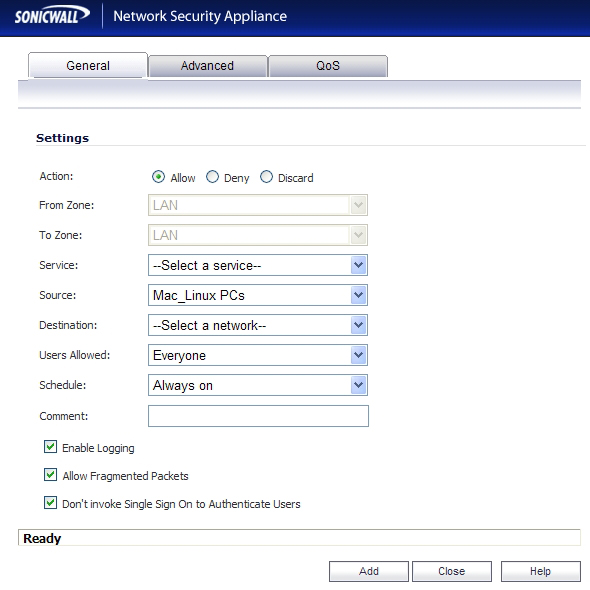
In the case of CFS, a rule with this checkbox enabled can be added “in front of” CFS so that
HTTP sessions from Mac and Linux systems are automatically redirected to log in, avoiding the need for these users to log in manually.
|
|
Note
|
Do not select the
Don't invoke Single Sign On to Authenticate Users
option for use with devices that are allowed to bypass the user authentication process entirely. Any devices that may be affected by an access rule when this option is enabled must be capable of logging in manually. A separate access rule should be added for such devices, with Users Allowed
set to All
.
|
If you have IP addresses that should always be allowed access without requiring user
authentication, they can be white-listed.
To white-list IP addresses so that they do not require authentication and can bypass SSO:
The default CFS policy will be applied to users at these IP addresses, and no IPS policies or
App Control policies that include particular users will be applied to them.
This method is appropriate for small numbers of IP addresses or to white-list subnets or IP
address ranges. It will work for large numbers of separate IP addresses, but could be rather inefficient.
You can use Access Rules to force users to log in via the Web UI when they cannot be
identified via Single Sign-On (SSO). Users need to be identfied for CFS, IPS, App Rules, or other policies to be correctly applied. An Access Rule can make the SonicWALL prompt the user for username and password.
If there are multiple CFS policies, or if IPS, App Rules, App Control, Anti-Spyware or DPI-SSL
have policies that are set to include/exclude certain users/user groups, then SSO is initiated to identify users. By default, if SSO fails to identify a user, the user is given access through the firewall while constrained by the default CFS policy or without the IPS policy, App Rule, or other policy being applied.
You can use Access Rules in conjunction with the above services to force all users to log in via
the Web UI with username/password when SSO fails, before they are allowed access through the firewall. Set an access rule that requires users to be authenticated, and that rule will initiate SSO. In this case, if SSO fails to identify the user they are blocked and, in the case of HTTP, redirected to the login page.
That can be done in one of two ways. The source zone is shown as LAN here, but can be any
applicable zone(s):
|
1.
|
Change
Users Allowed
in the default LAN -> WAN rule to Everyone
or Trusted
Users
. These are authenticated users. Then add rules to allow out traffic that you do not want to be blocked for unidentified users (such as DNS, email, ...) with Users Allowed
set to All
.
|

|
2.
|
Leave the default LAN -> WAN rule allowing
All
users, and add a rule to allow HTTP and HTTPS from addresses Any to Any with Users Allowed
set to Everyone
or Trusted Users
. You can also include other services along with HTTP/HTTPS if you do not want those being used by unauthenticated users.
|

Of these, option 1 is the more secure option, but is also the more likely to cause problems by
blocking unforeseen things that should be allowed access without authentication.
In Windows, outgoing ICMP pings from users on the Terminal Server are not sent via a socket
and so are not seen by the TSA, and hence the appliance will receive no notifications for them. Therefore, if firewall rules are using user level authentication and pings are to be allowed through, you must create separate access rules to allow them from “All”.
Similarly, outgoing user requests using Fully Qualified Domain Names (FQDN) rather than IP
addresses require that DNS traffic be allowed through. To allow Terminal Server users to use FQDNs, you must create a firewall access rule that allows DNS traffic from “All”.
Firewall access rules provide the administrator with the ability to control user access. Rules set
under Firewall > Access Rules
are checked against the user group memberships returned from a SSO LDAP query, and are applied automatically. Access rules are network management tools that allow you to define inbound and outbound access policy, configure user authentication, and enable remote management of the SonicWALL security appliance. The SonicOS Firewall > Access Rules
page provides a sortable access rule management interface.
By default, SonicWALL security appliance’s stateful packet inspection allows all communication
from the LAN to the Internet, and blocks all traffic to the LAN from the Internet.
Additional network access rules can be defined to extend or override the default access rules.
For example, access rules can be created that block certain types of traffic such as IRC from the LAN to the WAN, or allow certain types of traffic, such as Lotus Notes database synchronization, from specific hosts on the Internet to specific hosts on the LAN, or restrict use of certain protocols such as Telnet to authorized users on the LAN.
For detailed information about access rules, see
“Firewall > Access Rules”
.
The SonicWALL appliance normally grants access through policies based on authentication
credentials supplied via HTTP login for one user at an IP address. For users on a terminal server, this method of authenticating one user per IP address is not possible. However, HTTP login is still allowed from a terminal server only for the purpose of administration of the appliance, subject to the following limitations and requirements:
This section provides information to help you manage SSO on your SonicWALL appliance. See
the following sections:
The
Users > Status
page displays Active User Sessions
on the SonicWALL security appliance. The table lists User Name
, IP Address
, Session Time
, Time Remaining
, Inactivity Remaining
, Settings
, and Logout
. For users authenticated using SonicWALL SSO Agent, the message Auth. by SSO Agent
will display. To logout a user, click the delete  icon next to the user’s entry.
icon next to the user’s entry.
|
|
Note
|
Changes in a user’s settings, configured under
Users > Settings
, will not be reflected during that user’s current session; you must manually log the user out for changes to take effect. The user will be transparently logged in again, with the changes reflected.
|
The
Users > Settings
page provides the administrator with configuration options for user session settings, global user settings, and acceptable use policy settings, in addition to SSO and other user login settings.
The
Enable login session limit
and corresponding Login session limit (minutes) s
ettings under User Session Settings apply to users logged in using SSO. SSO users will be logged out according to session limit settings, but will be automatically and transparently logged back in when they send further traffic.
Changes applied in the
Users > Settings
page during an active SSO session will not be reflected during that session.
In SonicOS Enhanced 5.6 and above, the Packet Monitor feature available on
System >
Packet Monitor
provides two checkboxes to enable capture of decrypted messages to and from the SSO agent, and decrypted LDAP over TLS (LDAPS) messages.
In SonicOS Enhanced 5.5, this functionality was introduced in the Packet Capture feature
available on System > Packet Capture
.
To capture decrypted messages to or from the SSO authentication agent, perform the following
steps:
|
Step 1
|
Click the
Configuration
button in the System > Packet Monitor
page
|
|
Step 3
|
Select the
Monitor intermediate Packets
checkbox.
|
|
Step 4
|
Select the
Monitor intermediate decrypted Single Sign On agent messages
checkbox.
|

The packets will be marked with
(sso)
in the ingress/egress interface field. They will have dummy Ethernet, TCP, and IP headers, so some values in these fields may not be correct.
This will enable decrypted SSO packets to be fed to the packet monitor, but any monitor filters
will still be applied to them.
Captured SSO messages are displayed fully decoded on the
System > Packet Monitor
screen.
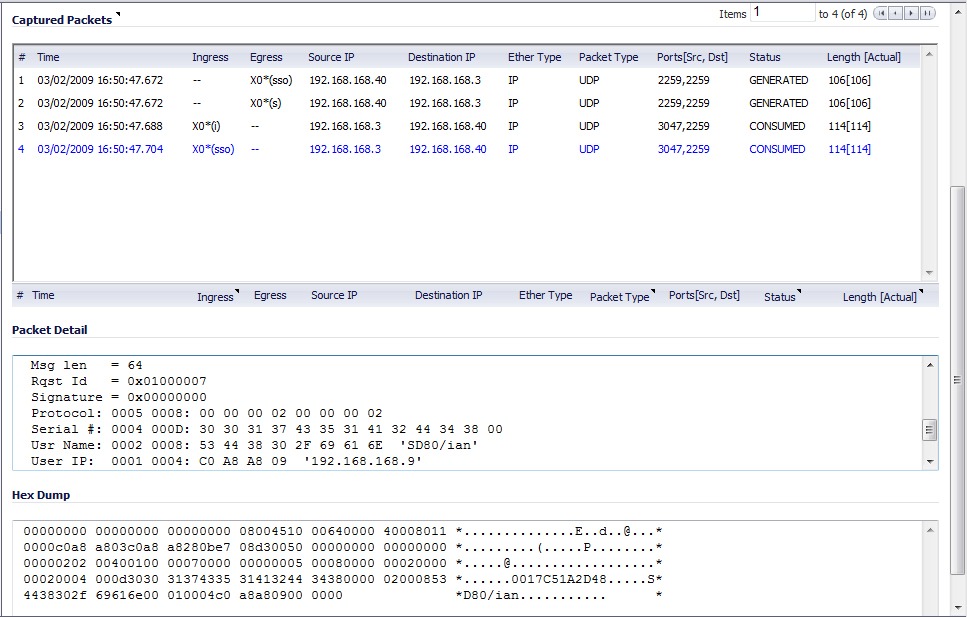
To capture decrypted LDAP over TLS (LDAPS) packets, perform the following steps:
|
Step 1
|
Click the
Configuration
button in the System > Packet Monitor
page
|
|
Step 3
|
Select the
Monitor intermediate Packets
checkbox.
|
|
Step 4
|
Select the
Monitor intermediate decrypted LDAP over TLS packets
checkbox.
|

The packets will be marked with
(ldp)
in the ingress/egress interface field. They will have dummy Ethernet, TCP, and IP headers, so some values in these fields may not be correct. The LDAP server port will be set to 389 so that an external capture analysis program (such as Wireshark) will know to decode these packets as LDAP. Passwords in captured LDAP bind requests will be obfuscated. The LDAP messages are not decoded in the Packet Monitor display, but the capture can be exported and displayed in WireShark to view them decoded.
This will enable decrypted LDAPS packets to be fed to the packet monitor, but any monitor
filters will still be applied to them.
This section contains the following subsections:
To configure additional administrator user profiles, perform the following steps:
|
Step 3
|
Enter a
Name
and Password
for the user.
|
|
Step 8
|
Select the
Log out
radio button for the On preemption by another administrator
option and click Accept
.
|
When using RADIUS or LDAP authentication, if you want to ensure that some or all
administrative users will always be able to manage the appliance, even if the RADIUS or LDAP server becomes unreachable, then you can use the RADIUS + Local Users
or LDAP + Local
Users
option and configure the accounts for those particular users locally.
For users authenticated by RADIUS or LDAP, create user groups named
SonicWALL
Administrators
and/or SonicWALL Read-Only Admins
on the RADIUS or LDAP server (or its back-end) and assign the relevant users to those groups. Note that in the case of RADIUS you will probably need special configuration of the RADIUS server to return the user group information – see the SonicWALL RADIUS documentation for details.
When using RADIUS or LDAP authentication, if you want to keep the configuration of
administrative users local to the appliance whilst having those users authenticated by RADIUS/LDAP, perform these steps:
|
Step 2
|
Select either the
RADIUS + Local Users
or LDAP + Local Users
authentication method.
|
|
Step 4
|
For RADIUS, click on the
RADIUS Users
tab and select the Local configuration only radio
button and ensure that the Memberships can be set locally by duplicating RADIUS user
names
checkbox is checked.
|
|
Step 5
|
For LDAP, click on the
LDAP Users
tab and select the User group membership can be set
locally by duplicating LDAP user names
checkbox.
|
When an administrator attempts to log in while another administrator is logged in, the following
message is displayed. The message displays the current administrator’s user name, IP address, phone number (if it can be retrieved from LDAP), and whether the administrator is logged in using the GUI or CLI.
This window gives you three options:
|
|
•
|
Continue
- Preempts the current administrator. The current administrator is dropped to non-config mode and you are given full administrator access.
|
|
|
•
|
Non-config
- You are logged into the appliance in non-config mode. The current administrator’s session is not disturbed.
|
|
|
•
|
Cancel
- Returns to the authentication screen.
|
When logging in as a user with administrator rights (that is not the
admin
user), the User Login
Status
popup window is displayed.
To go to the SonicWALL user interface, click the
Manage
button. You will be prompted to enter your password again. This is a safeguard to protect against unauthorized access when administrators are away from their computers and do not log out of their session.
You can disable the
User Login Status
popup window if you prefer to allow certain users to log in solely for the purpose of managing the appliance, rather than for privileged access through the appliance. To disable the popup window, select the Members go straight to the management
UI on web login
checkbox when adding or editing the local group.
If you want some user accounts to be administrative only, while other users need to log in for
privileged access through the appliance, but also with the ability to administer it (that is, some go straight to the management interface on login, while others get the User Login Status
popup window with a Manage
button), this can be achieved as follows:
To switch from non-config mode to full configuration mode, perform the following steps:
|
Step 2
|
In the
Web Management Settings
section, click on the Configuration mode
button. If there is not currently an administrator in configuration mode, you will automatically be entered into configuration mode.
|
|
Step 4
|
Click the
Continue
button to enter configuration mode. The current administrator is converted to read-only mode and you are given full administrator access.
|
User accounts with administrator and read-only administrators can be viewed on the
Users >
Local Groups
page.
Administrators can determine which configuration mode they are in by looking at either the top
right corner of the management interface or at the status bar of their browser.
To display the status bar in Firefox and Internet Explorer, click on the
View
menu and enable status bar
. By default, Internet Explorer 7.0 and Firefox 2.0 do not allow Web pages to display text in the status bar. To allow status bar messages in Internet Explorer, go to Tools > Internet
Options
, select the Security
tab, click on the Custom Level
button, scroll to the bottom of the list, and select Enable
for Allow Status Bar Updates Via Script
.
To allow status bar messages in Firefox, go to
Tools > Options
, select the Content
tab, click the Advanced
button, and select the checkbox for Change Status Bar Text
in the pop-up window that displays.
When the administrator is in full configuration mode, no message is displayed in the top right
corner and the status bar displays Done
.
When the administrator is in read-only mode, the top right corner of the interface displays
Read-Only Mode
.
The status bar displays
Read-only mode - no changes can be made
.
When the administrator is in non-config mode, the top right of the interface displays
Non-
Config Mode
. Clicking on this text links to the System > Administration
page where you can enter full configuration mode.
The status bar displays
Non-config mode - configuration changes not allowed
.
Log messages are generated for the following events:
A GUI user terminates either of the above management sessions (including when an admin
logs out).
![]() button.
button.
![]() above the left-hand navigation panel. You can also click the Edit
tab at the bottom of the right-hand window.
above the left-hand navigation panel. You can also click the Edit
tab at the bottom of the right-hand window.
![]() above the left-hand navigation panel.
above the left-hand navigation panel.
![]() . To stop services for an appliance, select the appliance from the left-hand navigation panel and click the stop button
. To stop services for an appliance, select the appliance from the left-hand navigation panel and click the stop button ![]() . To resume services, click the start button
. To resume services, click the start button ![]() .
.
![]() to the right of the SSO agent. This also works for individual TSAs on the Terminal Services tab.
to the right of the SSO agent. This also works for individual TSAs on the Terminal Services tab.
![]() icon next to the user’s entry.
icon next to the user’s entry.












































